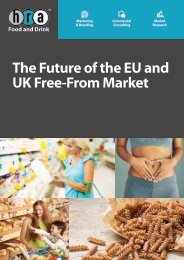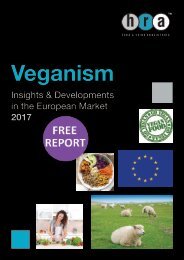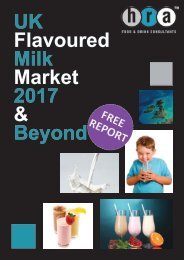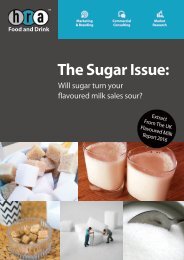FREE-UK-Flavoured-Milk-Report-2016-2017
The backdrop to the UK flavoured milk market is one of relentless change. The removal of the EU milk quotas, the transition to a Western-type diet by emerging economies, the UK sugar debate and the booming sports nutrition industry are all aspects of change that create both challenges and opportunities for the UK flavoured milk market. HRA Food and Drink Marketing has developed this report as a map to guide industry stakeholders. Although volume growth in 2014 was slightly lower than in previous years, the flavoured milk market still has plenty of room for product innovation and development. Overall, we expect the UK flavoured milk market to continue to grow over the medium term, but not without improving its nutritional profile. The sugar debate reached new heights when, in October 2015, Public Health England released a document suggesting Government intervention in the form of a sugar tax (levy). As a consequence, product reformulation has become a priority for all serious players in the market.
The backdrop to the UK flavoured milk market is one of relentless change. The removal of the EU milk quotas, the transition to a Western-type diet by emerging economies, the UK sugar debate and the booming sports nutrition industry are all aspects of change that create both challenges and
opportunities for the UK flavoured milk market.
HRA Food and Drink Marketing has developed this report as a map to guide industry stakeholders. Although volume growth in 2014 was slightly lower than in previous years, the flavoured milk market still has plenty of room for product innovation and development.
Overall, we expect the UK flavoured milk market to continue to grow over the medium term, but not without improving its nutritional profile. The sugar debate reached new heights when, in October 2015, Public Health England released a document suggesting Government intervention in the form of a sugar tax (levy). As a consequence, product reformulation has become a priority for all serious players in the market.
You also want an ePaper? Increase the reach of your titles
YUMPU automatically turns print PDFs into web optimized ePapers that Google loves.
<strong>UK</strong>#FLAVOURED#MILK#<strong>2016</strong>217#<br />
#<br />
1.3 Nutritional Profile<br />
•# Cows’ milk has higher levels of protein, calcium and phosphorus than<br />
human milk. The protein quality of this milk is considered to be of high<br />
quality because it has a broad range of essential amino acids.<br />
•# <strong>Milk</strong> is mostly comprised of water (68%).<br />
•# The main source of carbohydrate is lactose, which plays a role in the<br />
assimilation of calcium, magnesium and phosphorus and the usage of<br />
Vitamin D.<br />
•# Cows’ milk naturally has between 4-5g of lactose, 3.5-4g of protein and<br />
between 3.75g-4g of fat per 100g (5).<br />
•# Cows’ milk has more saturated fat than human milk with 65-75g per<br />
100g. Oleic acid is the monounsaturated fatty acid most present. Linoleic<br />
acid content varies between 0.1g-2.2g per 100g (5).<br />
•#<br />
•#<br />
<strong>Milk</strong>#is#a#good#source#of#the#minerals#Calcium,#Magnesium,#<br />
Phosphorus,#Sodium,#Zinc#and#Copper.#<br />
<strong>Milk</strong>#is#a#good#source#of#Vitamin#A,#Niacin,#Folate#and#Vitamin#D.##<br />
For an adult between the ages of 18 to 70, the following tables show the<br />
mineral and vitamin content of cows’ milk per 100 grams.<br />
Minerals Range<br />
Daily<br />
requirement<br />
RDA<br />
Calcium (mg) 120 2500 5%<br />
Iron (mg) 0.2 45 0%<br />
Magnesium (mg) 11 350 3%<br />
Phosphorus (mg) 95 4000 2%<br />
Sodium (mg) 45 2300 2%<br />
Zinc (mg) 0.4 40 1%<br />
Copper (mg) 0 10000 0%<br />
Selenium (μg) 3.7 400 1%<br />
Manganese (μg) 10 2300 0%<br />
Figure 1-1: Mineral content of cow’s milk per 100 grams (5).<br />
Vitamins<br />
Range<br />
Daily<br />
requirement<br />
RDA<br />
Vitamin A (μg) 46 3000 2%<br />
Niacin (mg) 0.2 35 1%<br />
Vitamin B6 (mg) 0.06 100 0%<br />
Folate (μg) 8 1000 1%<br />
Vitamin C (mg) 2 2000 0%<br />
Vitamin D (μg) 0.3 50 1%<br />
Figure 1-2: Vitamin content of cow’s milk per 100 grams (5).<br />
# 14#<br />
All rights reserved, ©Teepee#Ltd,#t/a#HRA#Food#&#Drink:#<strong>2016</strong>#<br />
to#<strong>2017</strong>#







